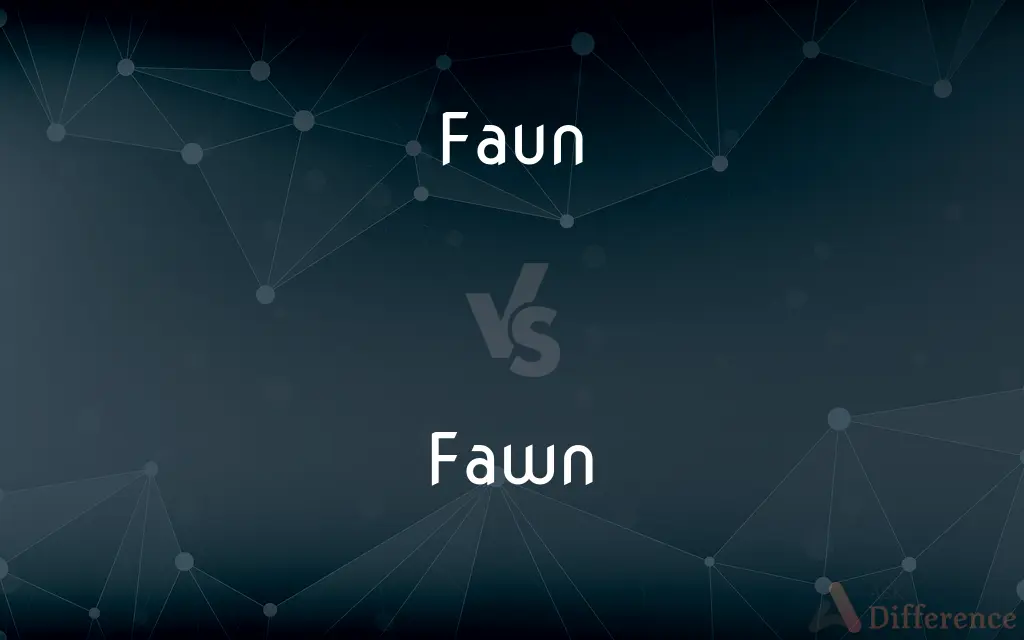Faun vs. Fawn — What's the Difference?
Edited by Tayyaba Rehman — By Maham Liaqat — Updated on April 22, 2024
A faun is a mythical creature that is part human and part goat, whereas a fawn is a young deer.

Difference Between Faun and Fawn
Table of Contents
ADVERTISEMENT
Key Differences
A faun, in Roman mythology, is depicted as a creature with the body of a man and the legs and horns of a goat. On the other hand, a fawn refers to a juvenile deer, identified by its small size and sometimes spotted coat.
Fauns are often associated with forests and natural settings, where they are portrayed as playful and mischievous spirits. Conversely, fawns are actual animals, vulnerable in their early life stages and often hidden in the forest by their mothers to protect them from predators.
In literature and art, fauns symbolize wildness and fertility, frequently appearing in stories and artworks that emphasize their connection to nature and pagan beliefs. Whereas fawns are commonly featured in nature documentaries and children's books, symbolizing innocence and the beauty of wildlife.
The faun's role in mythology includes being a companion of Pan and Dionysus, engaging in dances and rustic music, which highlights their festive and untamed nature. In contrast, the depiction of fawns in media often focuses on their development and the challenges they face growing up in the wild.
Both fauns and fawns are popular in different cultural expressions; fauns in myths and fantasy genres, and fawns in wildlife observation and as motifs in storytelling about the environment and animal behavior.
ADVERTISEMENT
Comparison Chart
Definition
Mythological creature, part human, part goat
Young deer
Origin
Roman mythology
Real world, various species of deer
Symbolism
Wildness, fertility, music, and dance
Innocence, vulnerability, and growth
Cultural Role
Featured in myths, stories, and art
Featured in nature documentaries, children's books
Habitat
Imaginary, often depicted in natural, wild settings
Forests, plains where deer populations live
Compare with Definitions
Faun
A character in Roman and Greek mythology, often connected to nature.
Mythological tales often include a faun as a guide or mischievous spirit.
Fawn
A young deer, especially in its first year.
The fawn stumbled as it followed its mother through the woods.
Faun
Represented as a creature of the forest and symbol of fertility.
In the painting, the faun danced under moonlight.
Fawn
Recognizable by its small size and sometimes spots on the coat.
A spotted fawn was camouflaged in the fall leaves.
Faun
A mythological hybrid of human and goat.
The sculpture depicted a faun playing a flute.
Fawn
A symbol of innocence and natural beauty in literature.
The storybook’s hero was a brave little fawn.
Faun
A common figure in fantasy literature and art.
The novel featured a wise faun who helped the lost travelers.
Fawn
Represents vulnerability in the animal kingdom.
Predators often target fawns due to their size and lack of speed.
Faun
Associated with playfulness and rustic music.
The faun character in the play pranced joyously around the stage.
Fawn
Often seen in wildlife documentaries as emblematic of early life stages in nature.
The documentary focused on a fawn’s first steps.
Faun
The faun (Latin: faunus, Ancient Greek: φαῦνος, phaunos, pronounced [pʰaunos]) is a mythological half human–half goat creature appearing in Roman mythology. The goat men, more commonly affiliated with the Satyrs of Greek mythology than the fauns of Roman, are bipedal creatures with the legs and tail of a goat and the head, torso, and arms of a man, and are often depicted with goat's horns and pointed ears.
Fawn
A young deer in its first year
A six-month-old roe fawn
Faun
Any of numerous rural deities represented as having the body of a man and the horns, ears, tail, and sometimes legs of a goat.
Fawn
A light brown colour
A fawn dress
Soft shades of pale green and fawn
Faun
(Roman mythology) A woodland creature with pointed ears, legs, and short horns of a goat and a fondness for unrestrained revelry.
Fawn
(of a deer) produce young
The forest was closed for hunting when the does were fawning
Faun
(entomology) Any of various nymphalid butterflies of the genus Faunis.
Fawn
(of a person) give a servile display of exaggerated flattery or affection, typically in order to gain favour
Congressmen fawn over the President
Faun
A god of fields and shipherds, diddering little from the satyr. The fauns are usually represented as half goat and half man.
Satyr or Faun, or Sylvan.
Fawn
To exhibit affection or attempt to please, as a dog does by wagging its tail, whining, or cringing.
Faun
Ancient Italian deity in human shape, with horns, pointed ears and a goat's tail; equivalent to Greek satyr
Fawn
To seek favor or attention by flattery and obsequious behavior.
Fawn
A young deer, especially one less than a year old.
Fawn
A grayish yellow-brown to moderate reddish brown.
Fawn
A young deer.
Fawn
A pale brown colour tinted with yellow, like that of a fawn.
Fawn
(obsolete) The young of an animal; a whelp.
Fawn
(rare) A servile cringe or bow.
Fawn
Base flattery.
Fawn
Of the fawn colour.
Fawn
(intransitive) To give birth to a fawn.
Fawn
(intransitive) To exhibit affection or attempt to please.
Fawn
(intransitive) To seek favour by flattery and obsequious behaviour (with on or upon).
Fawn
To show devotion or submissiveness by wagging its tail, nuzzling, licking, etc.
Fawn
A young deer; a buck or doe of the first year. See Buck.
Fawn
The young of an animal; a whelp.
[The tigress] . . . followeth . . . after her fawns.
Fawn
A fawn color.
Fawn
A servile cringe or bow; mean flattery; sycophancy.
Fawn
Of the color of a fawn; fawn-colored.
Fawn
To bring forth a fawn.
Fawn
To court favor by low cringing, frisking, etc., as a dog; to flatter meanly; - often followed by on or upon.
You showed your teeth like apes, and fawned like hounds.
Thou with trembling fear,Or like a fawning parasite, obeyest.
Courtiers who fawn on a master while they betray him.
Fawn
A color varying around light grayish brown;
She wore a dun raincoat
Fawn
Young deer
Fawn
Show submission or fear
Fawn
Try to gain favor by cringing or flattering;
He is always kowtowing to his boss
Fawn
Have fawns;
Deer fawn
Common Curiosities
What do fawns eat?
Fawns primarily drink their mother's milk initially, gradually transitioning to a diet of grasses and leaves.
Are fauns always male?
While traditionally depicted as male, fauns can be portrayed as female or gender-neutral in modern interpretations.
Can fawns survive without their mothers?
Fawns depend heavily on their mothers for protection and nourishment during the early weeks of their life.
How fast can a fawn run?
Fawns are capable of running within a few hours after birth, though they usually rely on stillness and camouflage to avoid predators.
Do fauns have any special powers in mythology?
In myths, fauns are often attributed with the power to influence human emotions and the natural environment around them.
How do fawns communicate with their mothers?
Fawns use soft bleats and body movements to communicate with their mothers, especially when in distress or hungry.
What is the significance of fauns in Roman culture?
Fauns were associated with rural deities and the untamed nature of the countryside, representing the Romans' agricultural roots and the wild aspects of their world.
What role do fauns play in festivals?
Fauns are celebrated in some cultural festivals symbolizing fertility and the arrival of spring, reflecting their mythological ties to nature and growth.
Do fauns interact with other mythical creatures?
In mythology, fauns often interact with other creatures such as nymphs, satyrs, and various gods of nature.
What is the lifespan of a fawn in the wild?
Deer, starting as fawns, can live up to 10 to 15 years in the wild, though many perish much younger due to predation or environmental factors.
What are the natural predators of fawns?
Natural predators include wolves, coyotes, mountain lions, and bears, depending on the geographic location.
How do fawns blend into their environment?
Fawns have a reddish-brown coat with white spots that helps them blend into the forest floor, a natural camouflage against predators.
How are fauns depicted in modern entertainment?
In modern films, books, and games, fauns are often portrayed as mystical guides, tricksters, or guardians of ancient secrets.
What are the differences between fauns and satyrs?
Though similar, fauns are Roman in origin and typically more benign, while satyrs are Greek and often portrayed as more lascivious and wild.
How do cultural representations of fauns and fawns differ around the world?
Cultural representations vary widely, with fauns often integrated into European folklore and arts, while fawns appear globally in various contexts related to wildlife and nature conservation.
Share Your Discovery

Previous Comparison
Executor vs. Executer
Next Comparison
Foot vs. LegAuthor Spotlight
Written by
Maham LiaqatEdited by
Tayyaba RehmanTayyaba Rehman is a distinguished writer, currently serving as a primary contributor to askdifference.com. As a researcher in semantics and etymology, Tayyaba's passion for the complexity of languages and their distinctions has found a perfect home on the platform. Tayyaba delves into the intricacies of language, distinguishing between commonly confused words and phrases, thereby providing clarity for readers worldwide.














































